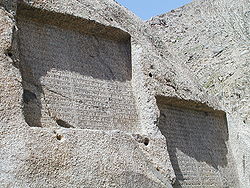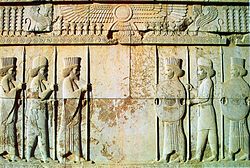This is an old revision of this page, as edited by 95.9.126.91 (talk) at 14:04, 17 June 2015. The present address (URL) is a permanent link to this revision, which may differ significantly from the current revision.
Revision as of 14:04, 17 June 2015 by 95.9.126.91 (talk)(diff) ← Previous revision | Latest revision (diff) | Newer revision → (diff)
Media (Old Persian: Māda, Middle Persian: Mād, Kurdih: Med) is a region of north-western Iran, best known for having been the political and cultural base of the Medes, and other ancient Iranian people. During the Achaemenid period, it comprised present-day Azarbaijan, Iranian Kurdistan and western Tabaristan. However, after the wars of Alexander the Great, the northern parts were separated and became known as Atropatene, while the remaining region became known as Lesser Media.
History
Under the Medes
In 678 BC, Deioces united the Median tribes of Media and made the first Iranian empire, his grandson, Cyaxares managed to unite all Iranian tribes of Ancient Iran and made his empire a major power. When Cyaxares died he was succeeded by his son, Astyages, who was the last king of the Median empire.
Under the Achaemenids


In 553 BC, Cyrus the Great, King of Persia, rebelled against his grandfather, the Median King, Astyages son of Cyaxares; he finally won a decisive victory in 550 BC resulting in Astyages' capture by his own dissatisfied nobles, who promptly turned him over to the triumphant Cyrus.
After Cyrus's victory against Astyages, the Medes were subjected to their close kin, the Persians. In the new empire they retained a prominent position; in honor and war, they stood next to the Persians; their court ceremony was adopted by the new sovereigns, who in the summer months resided in Ecbatana; and many noble Medes were employed as officials, satraps and generals. Interestingly, at the beginning the Greek historians referred to the Achaemenid Empire as a Median empire.
After the assassination of the usurper Smerdis, a Mede Fravartish (Phraortes), claiming to be a scion of Cyaxares, tried to restore the Mede kingdom, but was defeated by the Persian generals and executed in Ecbatana (Darius I in the Behistun inscription). Another rebellion, in 409 BC, against Darius II was of short duration. But the Iranian tribes to the north, especially the Cadusii, were always troublesome; many abortive expeditions of the later kings against them are mentioned.
Under Persian rule, the country was divided into two satrapies: the south, with Ecbatana and Rhagae (Rey near modern Tehran), Media proper, or Greater Media, as it is often called, formed in Darius I the Great's organization the eleventh satrapy, together with the Paricanians and Orthocorybantians; the north, the district of Matiane, together with the mountainous districts of the Zagros and Assyria proper (east of the Tigris) was united with the Alarodians and Saspirians in eastern Armenia, and formed the eighteenth satrapy.
When the Persian empire decayed and the Cadusii and other mountainous tribes made themselves independent, eastern Armenia became a special satrapy, while Assyria seems to have been united with Media; therefore Xenophon in the Anabasis always designates Assyria by the name of "Media".
Under the Seleucids
Main article: AtropateneFollowing Alexander's invasion of the satrapy of Media in the summer of 330 BC, he appointed as satrap a former general of Darius III the Great named Atropates (Atrupat) in 328 BC, according to Arrian. In the partition of his empire, southern Media was given to the Macedonian Peithon; but the north, far off and of little importance to the generals squabbling over Alexander's inheritance, was left to Atropates.
While southern Media, with Ecbatana, passed to the rule of Antigonus, and afterwards (about 310 BC) to Seleucus I, Atropates maintained himself in his own satrapy and succeeded in founding an independent kingdom. Thus the partition of the country, that Persia had introduced, became lasting; the north was named Atropatene (in Pliny, Atrapatene; in Ptolemy, Tropatene), after the founder of the dynasty, a name still said to be preserved in the modern form 'Azerbaijan'.
The capital of Atropatene was Gazaca in the central plain, and the castle Phraaspa, discovered on the Araz river by archaeologists in April 2005.
Atropatene is that country of western Asia which was least of all other countries influenced by Hellenism; there exists not even a single coin of its rulers. Southern Media remained a province of the Seleucid Empire for a century and a half, and Hellenism was introduced everywhere. Media was surrounded everywhere by Greek towns, in pursuance of Alexander's plan to protect it from neighboring barbarians, according to Polybius. Only Ecbatana retained its old character. But Rhagae became the Greek town Europus; and with it Strabo names Laodicea, Apamea Heraclea or Achais. Most of them were founded by Seleucus I and his son Antiochus I.
Under the Arsacids
In 221 BC, the satrap Molon tried to make himself independent (there exist bronze coins with his name and the royal title), together with his brother Alexander, satrap of Persis, but they were defeated and killed by Antiochus the Great. In the same way, the Mede satrap Timarchus took the diadem and conquered Babylonia; on his coins he calls himself the great king Timarchus; but again the legitimate king, Demetrius I, succeeded in subduing the rebellion, and Timarchus was slain. But with Demetrius I, the dissolution of the Seleucid Empire began, brought about chiefly by the intrigues of the Romans, and shortly afterwards, in about 150, the Parthian king Mithradates I conquered Media.
From this time Media remained subject to the Arsacids or Parthians, who changed the name of Rhagae, or Europus, into Arsacia, and divided the country into five small provinces. From the Parthians, it passed in 226 to the Sassanids, together with Atropatene.
Language and literature
Main article: Median languageThe Medes spoke Median, a north-western Iranian language.
References
- Encyclopædia Britannica Online Media (ancient region, Iran)
- Briant, Pierre (2006). From Cyrus to Alexander: A History of the Persian Empire. Eisenbrauns. p. 31.
- Herodotus, The Histories, p. 93.
- Xenophon, Hellen. 2, 19
- Rudiger Schmitt, "Cadusii" in Encyclopedia Iranica
- ^ Meyer, Eduard (1911). "Media" . In Chisholm, Hugh (ed.). Encyclopædia Britannica (11th ed.). Cambridge University Press. p. 21.
- Herodotus iii. 92
- Herod. iii. 94; cf. v. 49, 52, VII. 72
- Polybius, x. 27
- Strabo, xi. 524
- Justin xli. 6
- Strabo xi. 524
- Isidorus Charac.
Notes
- A)"..and the Medes (Iranians of what is now north-west Iran).." EIEC (1997:30). B) "Archaeological evidence for the religion of the Iranian-speaking Medes of the .." (Diakonoff 1985, p. 140) harv error: no target: CITEREFDiakonoff1985 (help). C) ".. succeeded in uniting into a kingdom the many Iranian-speaking Median tribes" ( from Encyclopædia Britannica ). D) "Proto-Iranian split into Western (Median, ancient Persian, and others) and Eastern (Scythian, Ossetic, Saka, Pamir and others)..." (Kuz'mina, Elena E. (2007), The origin of the Indo-Iranians, J. P. Mallory (ed.), BRILL, p. 303, ISBN 978-90-04-16054-5) ...
| ||
|---|---|---|
|  | |
| See also Taxation districts of the Achaemenid Empire (according to Herodotus) | ||
37°N 47°E / 37°N 47°E / 37; 47
Categories: